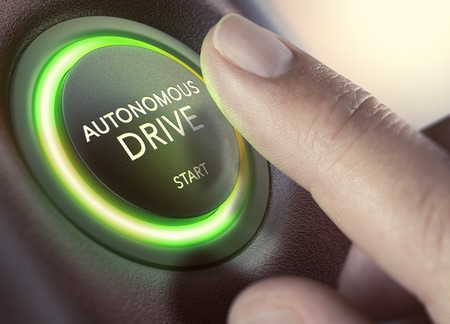 Autonomous, or self-driving, vehicles are coming, even if it’s going to take some time for the technology to become fully operational on U.S. highways. When the technology catches up with the commercial demand, however, there’s little doubt that the market for autonomous vehicles will be huge. News reports from last June indicate that market research firm IHS Automotive published a report forecasting that almost 21 million driverless cars will be driven on roads across the world by the year 2035. This June, business news outlet CNBC reported on a study co-produced by computer chip firm Intel Corporation (NASDAQ:INTC) which predicts that the global passenger economy will hit $7 trillion by the year 2050.
Autonomous, or self-driving, vehicles are coming, even if it’s going to take some time for the technology to become fully operational on U.S. highways. When the technology catches up with the commercial demand, however, there’s little doubt that the market for autonomous vehicles will be huge. News reports from last June indicate that market research firm IHS Automotive published a report forecasting that almost 21 million driverless cars will be driven on roads across the world by the year 2035. This June, business news outlet CNBC reported on a study co-produced by computer chip firm Intel Corporation (NASDAQ:INTC) which predicts that the global passenger economy will hit $7 trillion by the year 2050.
In recent weeks, activity on Capitol Hill has been ramping up in order to clear the path towards more self-driving cars on American roads. Reports from early June from Eno Transportation Weekly indicates that House Republicans sitting on the House Energy and Commerce Committee are currently considering a total of 16 bills which would increase testing and deployment of autonomous cars in the U.S. In late June, a representative from self-driving car alliance Advocates for Highway and Auto Safety testified in front of the House energy committee asking the committee to make sure that any proposed bills had enough federal oversight to ensure safety and accountability among self-driving manufacturers.
The state of the technology is starting to prove itself worthy of road tests, even in areas where human drivers are very common. In mid-July, a self-driving car developed by autonomous firm Torc Robotics completed a trip of more than 2,500 miles, traveling from Washington, D.C., to Seattle, WA, while navigating aggressive traffic, heavy rains and detours. That’s nearly five times the length that a self-driving car built by German automaker Audi AG (ETR:NSU) traveled in early 2015, making it’s way 560 miles to arrive at that year’s Consumer Electronics Show.
Despite forays into the automotive world by Silicon Valley contenders like Tesla (NASDAQ:TSLA), Google’s Waymo and Uber, it seems that the coming generation of American research and development for self-driving cars will be centered in Detroit, long the center of the American automotive world. Reports on a study from Navigant Research shows that Ford Motor Company (NYSE:F) is the best-positioned automaker in the world in terms of development and deployment of self-driving technologies. General Motors (NYSE:GM), who placed second in the Navigant report, announced in mid-July that the firm was ready to begin mass production of autonomous vehicles, having already reached a test fleet of 180 self-driving cars.
The race to full commercialization of self-driving vehicles to consumers is already a global one. At the recent reveal of the Audi A8 luxury vehicle in mid-July, the German automaker announced that, not only does it plan to sell the world’s first car with Level 3 autonomy, it’s also conducting research via an augmented reality test bed to see how people will physically and emotionally react to riding in a self-driving car. French electric self-driving shuttle developer Navya SAS recently announced its plans to build a 20,000-square-foot production facility in Saline, MI, a $1 million investment expected to create up to 50 jobs.
Against this backdrop, please join us on Thursday, July 20th, at 2pm ET for a free webinar discussion. Patent attorney and IPWatchdog founder Gene Quinn will host a webinar titled The Patent Race to Driverless Technology, sponsored by CPA Global. Gene and a panel of experts will discuss various issues important to the coming autonomous sector including the center of research and development in the field, regulations being considered by the U.S. Department of Transportation and the effects of case law or market forces on the investment in autonomous vehicle patents. Click here to register for the live webinar or to receive a recording of the complete webinar afterwards.

![[IPWatchdog Logo]](https://ipwatchdog.com/wp-content/themes/IPWatchdog%20-%202023/assets/images/temp/logo-small@2x.png)

![[Advertisement]](https://ipwatchdog.com/wp-content/uploads/2024/04/Patent-Litigation-Masters-2024-sidebar-early-bird-ends-Apr-21-last-chance-700x500-1.jpg)

![[Advertisement]](https://ipwatchdog.com/wp-content/uploads/2021/12/WEBINAR-336-x-280-px.png)
![[Advertisement]](https://ipwatchdog.com/wp-content/uploads/2021/12/2021-Patent-Practice-on-Demand-recorded-Feb-2021-336-x-280.jpg)
![[Advertisement]](https://ipwatchdog.com/wp-content/uploads/2021/12/Ad-4-The-Invent-Patent-System™.png)







Join the Discussion
One comment so far.
John Fetter
August 26, 2017 08:18 amSomebody asserted a few months ago that most automobile accidents are caused by people due to speeding, tail gating, inattentive driving, reckless lane changes – and added triumphantly that these are things machines won’t do.
As more and more driverless cars hit the road, inevitably, driverless cars will be involved in more and more accidents, and those accidents will be of concern to their makers. The makers of driverless cars will triumphantly produce recordings of the journeys undertaken by their vehicles that will always appear to show their cars to be blameless.
“The fifty-one school children were to blame, not the blameless driverless car.”
Soon blameless driverless cars will be driving into other blameless driverless cars. And the recordings of journeys undertaken by driverless cars will be revealed to be mostly fake – because that is how people have always done things and will always do things.
The obvious flaw that all 12-year-olds easily spotted, but big business was unable to see, will have the public will going after driverless cars in the years to come with more anger and determination than they went after the likes of asbestos